Airfix 1/48 Javelin FAW.9
|
KIT #: |
A12007 |
|
PRICE: |
$75.00 SRP |
|
DECALS: |
Three options |
|
REVIEWER: |
Tom Cleaver |
|
NOTES: |
Xtradecal 48125 “Javelin part 1" used
|

In 1947, the Air
Ministry released a requirement for a high-performance night fighter under
F.44/46, which called for a two‑seat night fighter capable in intercepting enemy
aircraft at 40,000 feet with a maximum speed in excess of 525 knots at altitude.
Able to climb tp 45,000 feet within ten minutes of engine start.
On April 13, 1949, the Ministry of Supply issued production orders to
Gloster and de Havilland, for four prototypes of their competing designs. These
were the Gloster GA.5 and the de Havilland DH.110, which held the advantage of
also being under consideration for the Royal Navy. Development was delayed by
political cost‑cutting measures, with the number of prototypes reduced to two
each, then later changed back to four each.
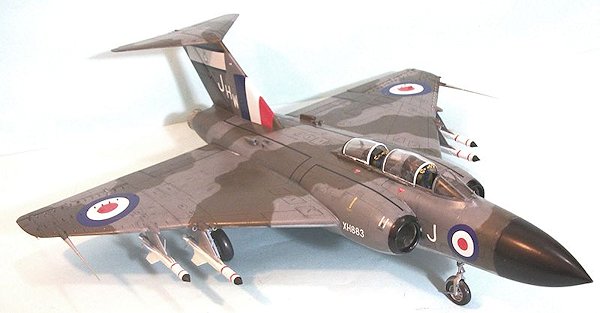 The Gloster GA.5 flew for the first time on November 26, 1951, at Moreton
Valence airfield. Chief Test Pilot
Bill Waterton, described the Javelin as being "as easy to fly as an Anson".
Disaster was averted during one test flight when the elevator surfaces detached;
despite the lack of control surfaces, Waterton was able to land successfully. He
was later awarded the George Medal for his actions to retrieve flight data from
the burning aircraft.
The Gloster GA.5 flew for the first time on November 26, 1951, at Moreton
Valence airfield. Chief Test Pilot
Bill Waterton, described the Javelin as being "as easy to fly as an Anson".
Disaster was averted during one test flight when the elevator surfaces detached;
despite the lack of control surfaces, Waterton was able to land successfully. He
was later awarded the George Medal for his actions to retrieve flight data from
the burning aircraft.
The second
prototype (WD808) crashed on June 11, 1953, killing test pilot Peter Lawrence
whop ejected too late at an altitude of only 400 feet. The Javelin had
experienced a "deep stall", with the large delta wing acting like an airbrake,
killing forward motion and at the same time stopping airflow over the elevators,
leaving them useless. A stall warning device was consequently specifically
developed and implemented for the Javelin.
The third prototype (WT827) was the first fitted with operational
equipment, including radar, and first flew March 7, 1953. On July 4, 1954, a
prototype Javelin accidentally achieved supersonic speed during a test flight
when the pilot was distracted the failure of the oxygen supply.
The Javelin was reportedly easy to fly, and could fly well on one engine
if necessary. The flight controls were fully power‑assisted, and production
aircraft adopted a hydraulic “feel” system for the pilot.
Turnaround time between sorties was significantly shorter than with the
Gloster Meteor due to improved accessibility and engine ignition.
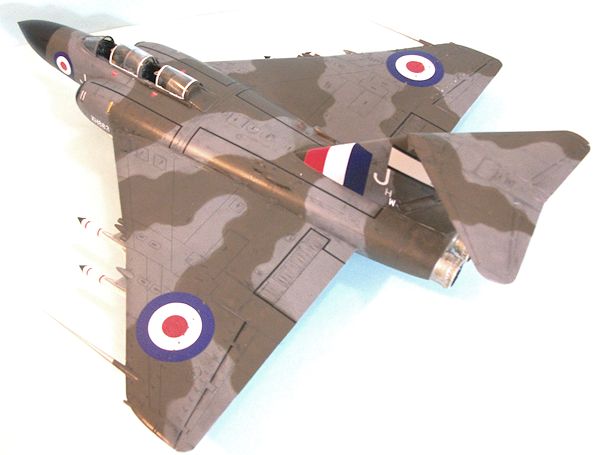 The Javelin entered service with 46 Squadron based at RAF Odiham in 1956.
During trials, it proved capable of intercepting
the English Electric Canberra over a hundred miles out to sea. The
introduction of the Javelin allowed the RAF to expand its night‑fighter activity
considerably, taking over night standby duty from American forces. By the end of
July 1959, all remaining Meteor squadrons had been converted to the Javelin.
The Javelin entered service with 46 Squadron based at RAF Odiham in 1956.
During trials, it proved capable of intercepting
the English Electric Canberra over a hundred miles out to sea. The
introduction of the Javelin allowed the RAF to expand its night‑fighter activity
considerably, taking over night standby duty from American forces. By the end of
July 1959, all remaining Meteor squadrons had been converted to the Javelin.
The closest the Javelin came to combat was during the Malaysian
Confrontation with Indonesia from September 1963 until August 1966. Javelins of
60 Squadron, later joined by 64 Squadron operated out of RAF Tengah, Singapore
flying combat patrols over the jungles of Malaysia. In 1964, an Indonesian Air
Force Lockheed C‑130 Hercules crashed while trying to evade interception by a
Javelin FAW.9 of 60 Squadron. During June 1967, following the disbandment of 64
Squadron, 60 Squadron was deployed to RAF Kai Tak in Hong Kong because of unrest
in the colony during China's Cultural Revolution. Javelins were also deployed to
Zambia during the early stages of Rhodesia's Unilateral Declaration of
Independence, to protect Zambia from any action by the Rhodesian Air Force. The
Javelin was withdrawn from service in 1968 with the disbandment of 60 Squadron
at RAF Tengah at the end of April 1968.
The Javelin FAW 9
was created by refitting 118 Javelin FAW 7s with the new “drooped” wing leading
edge and the SA.7r engines with afterburning originally introduced on the
Javeling FAW 8. 40 of these
aircraft were refitted with inflight refueling probes and provision for two
underwing drop tanks as the Javelin FAW 9R.
The only other 1/48 Javelin kit was the vacuform released by Dynavector,
which I reviewed
here.
While this was a very nice kit, it has been unavailable since Dynavector went o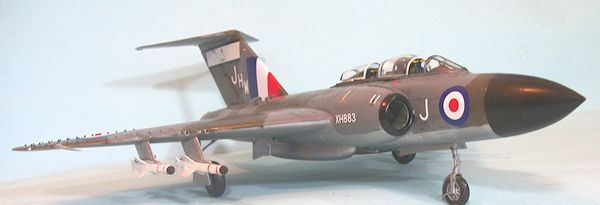 ut
of business. Editor's Note: Readers have informed me that Dynavector is still in business. Here is a link. This new
injection-molded kit completely replaces it.
ut
of business. Editor's Note: Readers have informed me that Dynavector is still in business. Here is a link. This new
injection-molded kit completely replaces it.
The parts molding of the kit is the best Airfix has ever done, with
petite engraved surface detail. The
airbrakes can be assembled open or closed, as can the flaps.
The cockpit is adequate for what’s needed, particularly since it is
painted black. The only thing that
can be improved with aftermarket detail parts are the seats.
The excellent decals are by Cartograf and feature holes in the upper wing
insignia to allow it to fit easily over the molded in vortex generators on the
wing.
I started with the cockpit, painting it with Tamiya “NATO Black,” then
detailing it with Prismacolor pencils in red, white, yellow, green and silver to
pick out detail. The kit seats were
used, 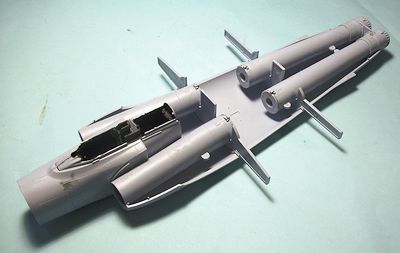 with
seat belts made from lead foil from a wine bottle.
with
seat belts made from lead foil from a wine bottle.
I followed the kit instructions for assembly of the fuselage, wings and
tail as sub-assemblies. Fit is
excellent throughout, with joints on panel lines.
I did not use any filler at all on the model.
I left off the radome until the rest of the airframe was assembled, then
filled the front of the fuselage ahead of the cockpit and the radome with enough
fishing weights to insure nose sitting.
Be aware that only the FAW 9R uses the drop tanks.
I armed this one with the four Firestreak missiles supplied in the kit.
The lower surface was painted with Alclad White Aluminum, while the upper
surface was painted with Tamiya Dark Sea Grey and RAF Dark Green mixed with
Tamiya Khaki to create a color close to postwar RAF Dark Green ,
which is closer to Olive Drab. I
then gave the model a coat of Future.
,
which is closer to Olive Drab. I
then gave the model a coat of Future.
I used the kit decals for the national insignia and stencils, and
XtraDecal 48125 “Javelin Part 1" to do FAW 9 XH883 flown by Wing Commander J.H.
Walton of 25 Squadron in 1960.
I gave the model
an overall coat of Xtracrylix Satin varnish to give a scale look to the glossy
paint scheme of the period, then attached the landing gear and canopies in the
open position, then finished by attaching the four missiles.
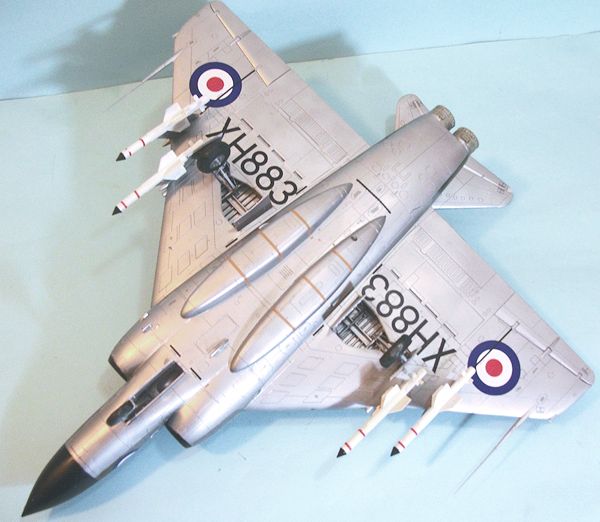 This new Javelin is definitely Airfix’s best kit ever, and puts them on
par with anything available from Hasegawa in terms of quality.
I have liked the Javelin ever since I first saw a photograph of one in
William Greene’s “The World’s Jet Airplanes, 1954.”
I was also fortunate to see the 60 Squadron Javelins at Tengah when the
old USS Rustbucket visited Singapore in 1964.
This new Javelin is definitely Airfix’s best kit ever, and puts them on
par with anything available from Hasegawa in terms of quality.
I have liked the Javelin ever since I first saw a photograph of one in
William Greene’s “The World’s Jet Airplanes, 1954.”
I was also fortunate to see the 60 Squadron Javelins at Tengah when the
old USS Rustbucket visited Singapore in 1964.
This kit is simple for anyone willing to follow the instructions.
A modeler of moderate skills will have no problem turning out a good
looking model from this kit. Highly
recommended.
Tom Cleaver
January 2014
Thanks to www.iModeler.com, which
provided the kit for review.
Decals courtesy of
Hannant’s. Order yours at the
link.
If you would like your product reviewed fairly and fairly quickly, please contact the editor or see other details in the
Note to
Contributors.
Back to the Main Page
Back to the Review
Index Page





 with
seat belts made from lead foil from a wine bottle.
with
seat belts made from lead foil from a wine bottle.
